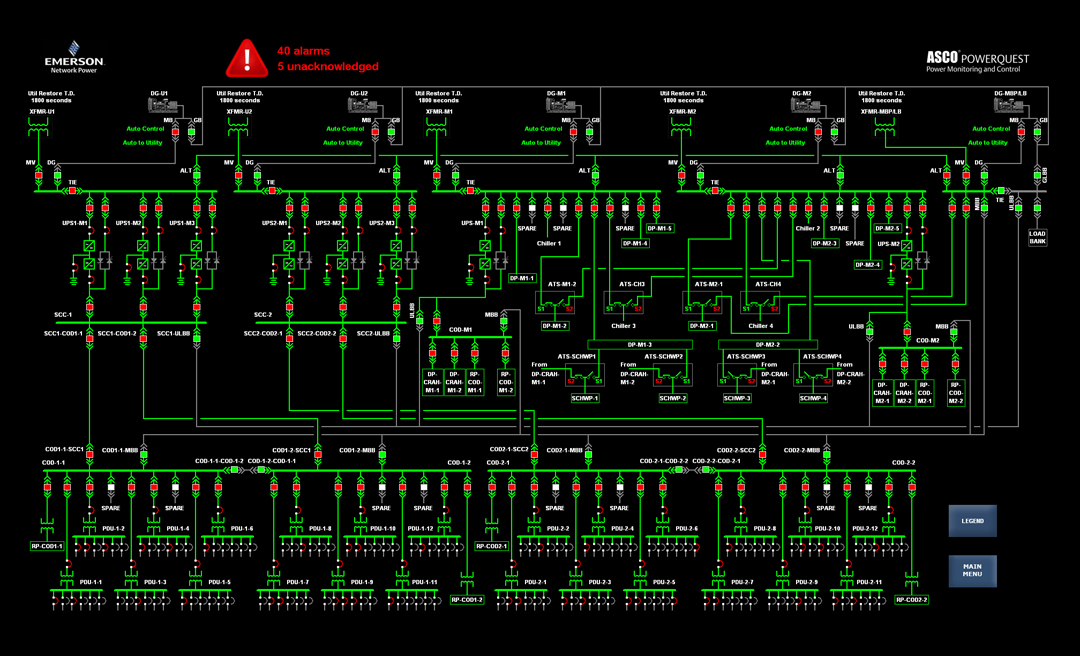 FLORHAM PARK, N.J. — Emerson Network Power has released a survey of facility executives showing a wide gap between emergency and backup power systems and the controls that monitor them. The gap is widest between the value of compliance reporting and its availability in power controls.
FLORHAM PARK, N.J. — Emerson Network Power has released a survey of facility executives showing a wide gap between emergency and backup power systems and the controls that monitor them. The gap is widest between the value of compliance reporting and its availability in power controls.
The results are based on a survey of nearly 1,000 facility executives in the U.S. that gauged the types of power monitoring and controls they have, the information they want from their systems and the functionalities that would help optimize power reliability.
According to the survey, more than half (54 percent) of facilities executives who responded to the survey said less than 25 percent of their load is on emergency or backup power. Yet, about three quarters (74 percent) said they would like more of their load backed up, so additional investment in onsite power is likely.
Expanding onsite power reflects the importance of avoiding costly downtime among facilities executives, especially those responsible for medical centers, high-end data centers and co-location facilities, and telecommunications facilities. Downtime for data centers, for example, costs more than $5,000-per-minute, according to a 2011 Ponemon Institute study of U.S.-based data centers.
Astonishingly, the survey also shows that controls for operating, monitoring, diagnosing and producing a variety of reports on these sophisticated power systems and the power distribution systems they interact with are not keeping pace. Three quarters (76 percent) of facilities executives reported their facilities do not have a single system to monitor, control and provide reporting and power quality analytics. Compliance reports, for example, can help satisfy regulatory requirements of the NFPA’s 70, 99 and 110 standards, NEC Article 708, EN50160 Power Quality Compliance and Joint Commission for hospitals. Incredibly, such reports are produced by less than 15 percent of power control systems.
A whitepaper titled “Critical Power Management Systems” details the survey findings. It includes comments by a range of facilities executives and consulting engineers who share insights and experiences with both sophisticated power systems and the power controls that operate them.
Four of 10 facilities executives surveyed rated power controls as critically important and want more information from their controls. About half (52 percent) said power controls need to be available 24/7.
Many facilities executives are not familiar with current technology and best practices. In addition, power controls often lack best-practices features in such areas as monitoring, control, reporting and power quality analytics. Best practice for power controls for business critical operations is a dedicated critical power management system to monitor, control, analyze and produce detailed reports, including high-end power quality analytics.
Monitoring, especially, is critical for identifying potential and actual operational issues. Of the two most common monitoring applications — generator and transfer switch status — only about half of executives reported their power controls monitor those parameters.
For control, a majority of respondents (60 percent) indicated their systems include the most common capability — stop/start. Other common capabilities — transfer control and changing settings — rate lower. Forty-eight and 40 percent of respondents’ systems, respectively, provide those functions.
In terms of reporting, comprehensive critical power management systems produce reports on alarm events, compliance, energy management, operational settings, historical logs and diagnostics. But, of the reports addressed in the survey, only one — alarms — is included in more than half (57 percent) of the power controls represented by surveyed executives.
Although power quality analytics are at the leading edge of power control technology, the survey indicates facilities executives use them far less than other controls capabilities.
A detailed needs assessment can help determine the level of monitoring and control needed for a given emergency or backup power system. One important consideration is a facility’s tolerance for downtime.
The whitepaper summarizing the survey findings is available at http://media.ascoapu.com/CPMS.pdf. For more information, visit www.EmersonNetworkPower.com/ASCO.




